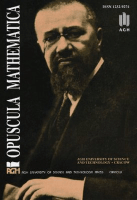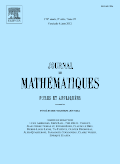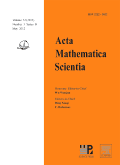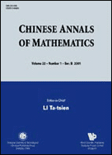
Opuscula Mathematica
Scope & Guideline
Exploring the Frontiers of Mathematical Thought
Introduction
Aims and Scopes
- Graph Theory:
The journal extensively covers topics in graph theory, including domination, labeling, and coloring problems in graphs, highlighting significant combinatorial structures and their applications. - Partial Differential Equations (PDEs):
Research on both linear and nonlinear PDEs, particularly parabolic, elliptic, and hyperbolic equations, is a core focus, with studies addressing existence, uniqueness, and asymptotic behavior of solutions. - Functional Analysis and Operator Theory:
The journal publishes papers on spectral theory, functional spaces, and operator theory, exploring properties of various operators and their applications in mathematical physics and engineering. - Fractional Calculus and Nonlocal Problems:
Emerging research in fractional calculus, including fractional differential equations and nonlocal boundary value problems, is highlighted, showcasing the journal's commitment to contemporary mathematical methods. - Numerical Analysis and Computational Methods:
Numerical solutions to differential equations and various mathematical models are a significant focus, addressing practical implications and computational techniques. - Mathematical Modelling:
The journal encourages submissions that apply mathematical theories to real-world problems, especially in the fields of physics, engineering, and biological systems.
Trending and Emerging
- Advanced Graph Theory:
There is an increasing emphasis on advanced topics within graph theory, including complex graph structures and their applications, as evidenced by numerous recent studies on domination and coloring. - Nonlinear Dynamics and Stability Analysis:
Recent publications have shown a growing interest in nonlinear dynamical systems, particularly in the context of stability analysis and oscillation theory, which are crucial for understanding complex systems. - Fractional Differential Equations:
The rise in papers addressing fractional differential equations indicates a growing interest in nonlocal phenomena and their applications, marking a significant trend in mathematical research. - Mathematical Modelling in Applied Sciences:
There is a clear trend towards applying mathematical theories to model real-world problems, particularly in fluid dynamics, population dynamics, and other interdisciplinary fields. - Computational Techniques in Mathematics:
The journal has seen an increase in submissions that utilize computational methods for solving mathematical problems, reflecting a broader trend towards integrating numerical analysis with theoretical research.
Declining or Waning
- Classical Geometry:
There has been a noticeable decline in papers focusing on classical geometric problems, such as those involving Euclidean structures and traditional geometric constructions, possibly due to the rise of more abstract and computational approaches. - Elementary Number Theory:
Research in elementary number theory appears to be less prominent, with fewer papers addressing classical problems in prime numbers, divisibility, and modular arithmetic. - Discrete Mathematics without Graph Theory:
Topics in discrete mathematics that do not directly relate to graph theory, such as combinatorial designs and number sequences, have seen a reduction in focus, indicating a potential shift towards more graph-centric studies.
Similar Journals

Mediterranean Journal of Mathematics
Bridging Theory and Practice in the World of MathematicsThe Mediterranean Journal of Mathematics, published by SPRINGER BASEL AG, is a prominent platform dedicated to the advancement of mathematical research and education. Since its inception in 2004, this journal has been pivotal in disseminating high-quality research across various fields of mathematics, currently holding a notable Q2 ranking in the miscellaneous mathematics category as of 2023. With its ISSN 1660-5446 and E-ISSN 1660-5454, the journal enjoys a respected position in the academic community, evident by its Scopus rank of 129 out of 399 in General Mathematics, placing it in the 67th percentile. While primarily a subscription-based journal, it remains committed to providing a comprehensive resource for researchers, professionals, and students, fostering dialogue and exploration within the mathematical sciences. The Mediterranean Journal of Mathematics, based in Basel, Switzerland, continues to contribute significantly to the evolution of mathematical theory and practice, marking its relevance as we approach its 20th anniversary in 2024.

Ufa Mathematical Journal
Fostering Scholarly Dialogue for a Global Mathematical CommunityUfa Mathematical Journal, published by the Institute of Mathematics and Computer Center in Russia, is an esteemed platform dedicated to the dissemination of high-quality research in the field of mathematics. With its ISSN 2074-1863 and E-ISSN 2074-1871, the journal serves as a vital resource for mathematicians, researchers, and academicians seeking to explore innovative methodologies and findings in various mathematical domains. Although presently operating under a subscription model, the journal’s commitment to advancing mathematical knowledge is underscored by its rigorous peer-review process and its aim to contribute significantly to the global mathematical community. With a focus on original research articles, the Ufa Mathematical Journal plays an essential role in fostering scholarly dialogue and collaboration among professionals in the field.

JOURNAL DE MATHEMATIQUES PURES ET APPLIQUEES
Uniting Theory and Application in MathematicsJOURNAL DE MATHEMATIQUES PURES ET APPLIQUEES, published by Elsevier, serves as a pivotal resource for scholars and practitioners in the field of mathematics. With an ISSN of 0021-7824 and E-ISSN of 1776-3371, this esteemed journal is at the forefront of disseminating crucial research from 1997 to 2024. It is recognized for its prestigious Q1 rankings in both Applied Mathematics and Miscellaneous Mathematics categories in 2023, highlighting its significant influence in these domains. It holds impressive Scopus ranks—35th out of 399 in General Mathematics and 126th out of 635 in Applied Mathematics, placing it within the top percentiles of academic publications. Although it does not currently offer open access options, the journal's commitment to high-quality, peer-reviewed research ensures that it remains a crucial asset for ongoing developments in mathematical theory and application. Notably, with its headquarters in Amsterdam, the journal attracts a global readership eager to explore the latest advancements and applications in mathematics.

Moscow University Mathematics Bulletin
Exploring the Depths of Mathematical Theory and ApplicationMoscow University Mathematics Bulletin is a distinguished academic journal published by Springer International Publishing AG, focusing on the dynamic field of mathematics. With an ISSN of 0027-1322 and an E-ISSN of 1934-8444, this journal serves as a platform for innovative research and developments in various mathematics sub-disciplines, making significant contributions to both theoretical and applied mathematics. While it holds a Q3 ranking in the field of Mathematics (miscellaneous) for 2023, this journal remains dedicated to fostering academic discourse among mathematicians. Researchers, professionals, and students will find value in the diverse range of articles that embody rigor and creativity. Although currently not an Open Access publication, the journal provides numerous access options through institutional or personal subscriptions. From its inception in 2007 to its expected continuity until 2024, the Moscow University Mathematics Bulletin is committed to enhancing the understanding and appreciation of mathematical sciences.

Applied Mathematics E-Notes
Fostering Innovation Through Mathematical InsightsApplied Mathematics E-Notes, a prominent publication within the field of Applied Mathematics, is produced by the Department of Mathematics at Tsing Hua University in Taiwan. With its inception in 2001, the journal continues to serve as a vital resource for disseminating research findings, methodologies, and applications that advance the understanding of mathematical theories and their practical implications. Though currently categorized in Q4 within its field, the journal remains dedicated to fostering innovation and collaborative research, reflecting its growth potential in the coming years. The journal is accessible online, catering to a global audience of researchers, professionals, and students seeking to enrich their knowledge and engage with contemporary topics in applied mathematics. Through its commitment to open dialogue in mathematical sciences, Applied Mathematics E-Notes plays an essential role in bridging theoretical research with real-world applications.

Proceedings of the Institute of Mathematics and Mechanics
Advancing the Frontiers of Mathematics and MechanicsProceedings of the Institute of Mathematics and Mechanics is a pivotal journal in the field of mathematics, dedicated to the advancement and dissemination of cutting-edge research in various sub-disciplines. Published by INST MATHEMATICS & MECHANICS, NATL ACAD SCIENCES AZERBAIJAN, this journal plays a significant role in bridging local and international research communities. With an ISSN of 2409-4986 and E-ISSN of 2409-4994, it has gained recognition, attaining a Q3 ranking in the Miscellaneous Mathematics category and placing in the 67th percentile on Scopus. Run from 2017 to 2024, the journal serves as an accessible platform for scholars and practitioners, inviting contributions that advance theoretical knowledge and practical applications in mathematics. With an emphasis on quality and innovation, the Proceedings of the Institute of Mathematics and Mechanics stands out as a vital resource for those looking to stay at the forefront of mathematical research and its multifaceted applications in various fields.

Punjab University Journal of Mathematics
Exploring new dimensions in mathematical research.Punjab University Journal of Mathematics is a prestigious academic journal published by the Department of Mathematics at the University of Punjab, Pakistan. Dedicated to advancing the field of mathematics, this journal provides a platform for researchers, educators, and students to disseminate their findings, foster scholarly dialogue, and promote innovative mathematical research. With a strong focus on theoretical and applied mathematics, the journal maintains a rigorous peer-review process to ensure high-quality publications that significantly contribute to the mathematical community. Although currently not indexed in prominent databases, the journal aims to elevate its visibility and impact through consistent publication of cutting-edge research. The absence of Open Access reflects a commitment to quality and thorough review, but researchers are encouraged to seek out this valuable resource for its insights and diverse contributions to mathematics.

ACTA MATHEMATICA SCIENTIA
Fostering Scholarly Dialogue Across DisciplinesACTA MATHEMATICA SCIENTIA is a reputable academic journal published by Springer, primarily focusing on the interdisciplinary fields of mathematics and physics. With an ISSN of 0252-9602 and an E-ISSN of 1572-9087, the journal has established itself as an influential platform for researchers and professionals seeking to disseminate novel findings in these domains. Based in the Netherlands, the journal holds a commendable Q2 category ranking in both Mathematics and Physics & Astronomy for 2023, reflecting its significance in the academic community. With a focus extending from 1996 to 2024, ACTA MATHEMATICA SCIENTIA serves as a vital resource for scholars, offering insights that bridge theoretical and applied sciences. Published under rigorous peer review, the journal fosters a robust scholarly dialogue and encourages innovative research that challenges existing paradigms. While access is not open, the journal's contributions are of paramount importance for advancing knowledge in the mathematical sciences and their applications in physical contexts.

CHINESE ANNALS OF MATHEMATICS SERIES B
Illuminating the Path of Mathematical Discovery Since 1980CHINESE ANNALS OF MATHEMATICS SERIES B, published by Shanghai Scientific Technology Literature Publishing House, is a prominent journal dedicated to fostering research and development in the field of mathematics. With an ISSN of 0252-9599 and an E-ISSN of 1860-6261, this journal provides a platform for the dissemination of innovative mathematical theories and methodologies. As of 2023, it is categorized within the Q4 quartile in *Applied Mathematics* and has achieved a commendable Q3 rank in *Mathematics (miscellaneous)*, emphasizing its growing influence in academia. Despite not being an open-access publication, it serves as a valuable resource for researchers, professionals, and students seeking to explore diverse mathematical topics, particularly from a unique regional perspective. The journal's extensive publication history—from 1980 and continuing to 2024—demonstrates a longstanding commitment to advancing mathematical knowledge and providing insights into various disciplines related to mathematics.

European Journal of Mathematics
Exploring the Depths of Mathematical KnowledgeWelcome to the European Journal of Mathematics, a prominent publication that serves as a vital platform for disseminating high-quality research in the field of mathematics. Published by Springer International Publishing AG, this journal has witnessed significant growth since its inception in 2015 and is recognized for its contributions within the Q2 category of Mathematics (miscellaneous) as per the 2023 rankings. With an ISSN of 2199-675X and an E-ISSN of 2199-6768, the journal aims to foster innovation and collaboration among researchers, professionals, and students alike. Although it operates under a traditional access model, the journal's commitment to advancing mathematical knowledge and applications cannot be overstated. Positioned among the top-tier publications, the European Journal of Mathematics is an essential resource that encourages the exploration of emerging trends and theories in mathematics, making it indispensable for anyone striving to stay at the forefront of this dynamic field.